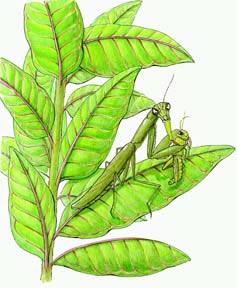

I am curious if praying mantis species' found here in the U.S. are poisonous because where I am from (Paraguay,South America) the name that the praying mantis is given translates to "mother of the snake" because it's venom is more deadly than that of a snake.
Praying Mantis are absolutely harmless to humans. In fact they are considered beneficial insects because they will eat garden pests. They are called preying mantis because they hold their front legs up in front of their faces and it looks like they are praying. This pose is really to wait for prey (no one knows what they are thinking). If an insect passes close by them they use these front legs to quickly grab them. They are fierce and efficient predators, but only dangerous to their prey (i.e. grasshoppers, katydids, etc.).
They are unusual in the insect world, because they can actually turn their heads to track moving prey. This ability, their big eyes and the spines on their legs (that help them grasp squirming prey) makes them look pretty fierce and people are often afraid of them. This fear and the use of the pesticide DDT led to the preying mantis almost being driven to extinction in the 1970s. They have now recovered nicely and can be seen in gardens and fields again throughout the country.
The Chinese mantid, which was imported in the early 1900s to help with agricultural pest control, is one of the more common mantids. Check out their movie: LINK.
For more information about them and to see a body diagram, check out them out in the animal section: LINK.
Thanks for your question!
When you research information you must cite the reference. Citing for websites is different from citing from books, magazines and periodicals. The style of citing shown here is from the MLA Style Citations (Modern Language Association).
When citing a WEBSITE the general format is as follows.
Author Last Name, First Name(s). "Title: Subtitle of Part of Web Page, if appropriate." Title: Subtitle: Section of Page if appropriate. Sponsoring/Publishing Agency, If Given. Additional significant descriptive information. Date of Electronic Publication or other Date, such as Last Updated. Day Month Year of access < URL >.
Amsel, Sheri. "Poisonous Praying Mantis?" Exploring Nature Educational Resource ©2005-2024. December 13, 2024
< http://www.exploringnature.org/db/view/Poisonous-Praying-Mantis >
